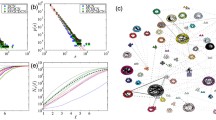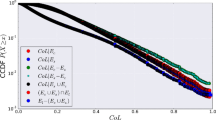Abstract
Recent studies on social network have spurred significant interests in human behaviors. Nowadays, various kinds of interpersonal human interactions, from mobile calls to emails, provide particular avenues to explore the inherent properties of communication patterns. In this article, we present a comprehensive study on a massive anonymous call records obtained from a major mobile service operator. The important difference laid in our work and previous mainly topological analyses is that we report on multiple aspects of the dataset. By investigating the calls of the users, we find out that most calls tend to last within one minute. Call duration between two females is much longer than that of two males. But calls of males generally involve more stations than that of female, indicating a larger mobile range of the males. We also observed that people tend to communicate more with each other when they share similar characters. Besides, the network is well-connected and robust to random attack. We also demonstrate that the close-knit sub-groups with little discrepancy in the characteristics of its involved users usually evoke more calls. Another interesting discovery is that call behaviors among people between workdays and weekends is obviously distinct. Generally speaking, the goal that we research on call network through multidimensional analyses is to uncover the intricate patterns of human communications and put up reasonable insights into future service intelligence.
Similar content being viewed by others
References
Onnela J P, Saramaki J, Hyvonen J, et al. Structure and tie strengths in mobile communication networks. In: Proceedings of the National Academy of Sciences. 2007, 104: 7332–7336
Nanavati A A, Gurumurthy S, Das G, et al. On the structural properties of massive telecom call graphs: findings and implications. In: Proceedings of the 15th ACM international conference on Information and knowledge management. 2006, 435–444
Dasgupta K, Singh R, Viswanathan B, et al. Social ties and their relevance to churn in mobile telecom networks. In: Proceedings of the 11th international conference on Extending database technology. 2008, 668–677
Backstrom L, Huttenlocher D, Kleinberg J, et al. Group formation in large social networks: membership, growth, and evolution. In: Proceedings of the 12th ACM SIGKDD international conference on Knowledge discovery and data mining. 2006, 44–54
Hidalgo C A, Rodriguez-Sickert C. The dynamics of a mobile phone network. Physica A: Statistical Mechanics and its Applications, 2008, 387(12): 3017–3024
Leskovec J, Horvitz E. Planetary-scale views on an instant-messaging network. In: Proceedings of the 17th international conference on World Wide Web. 2008, 915–924
Kumar R, Novak J, Tomkins A. Structure and evolution of online social networks. In: Proceedings of the 12th ACM SIGKDD international conference on Knowledge discovery and data mining. 2006, 611–617
Derenyi I, Palla G, Vicsek T. Clique percolation in random networks. Physical Review Letters, 2005, 94(16), DOI: 10.1103/Phys-RevLett.94.160202
Palla G, Derényi I, Farkas I, et al. Uncovering the overlapping community structure of complex networks in nature and society. Nature, 2007, 435(7043): 814–818
Watts D J, Strogatz S H. Collective dynamics of ’smallworld’ networks. Nature, 1998, 393(6684): 440–442
Newman M E J. Who Is the Best Connected Scientist? A Study of Scientific Coauthorship Networks. Complex Networks, 2004, 337–370
Newman M E J. The structure and function of complex networks. SIAM Review, 2003, 45: 167–256
Newman M E J, Strogatz S H, Watts D J. Random graphs with arbitrary degree distribution and their applications. Physical Review E, 2001, 64: 026118
Broder A, Kumar R, Maghoul F, et al. Graph structure in the Web. Computer Networks, 2000, 33: 309–320
Barabasi A L, Albert R. Emergence of scaling in random networks. Science, 1999, 286(5439): 509–512
Gonzalez M C, Hidalgo C A, Barabasi A L. Understanding individual human mobility patterns. Nature, 2008, 453(7196): 779–782
Clauset A, Newman M E J, Moore C. Finding community structure in very large networks. Physical Review E, 2004, 70(6), DOI: 10.1103/PhysRevE.70.066111
Albert R, Jeong H, Barabasi A L. Error and attack tolerance of complex networks. Nature, 2000, 406(6794): 378–382
Callaway D S, Newman ME J, Strogatz S H, et al. Network robustness and fragility: Percolation on random graphs. Physical Review Letters, 2000, 85: 5468–5471
Palla G, Barabasi A L, Vicsek T. Quantifying social group evolution. Nature, 2007, 466(7136): 664–667
Lin Y R, Chi Y, Zhu S, et al. Facetnet: a framework for analyzing communities and their evolutions in dynamic networks. In: Proceedings of the 17th international conference on World WideWeb. 2008, 685–694
Sun J, Faloutsos C, Papadimitriou S, et al. Graph-scope: parameterfree mining of large time-evolving graphs. In: Proceeding of the 13th ACM SIGKDD international conference on Knowledge discovery and data mining, 2007, 687–696
Author information
Authors and Affiliations
Corresponding author
Rights and permissions
About this article
Cite this article
Yang, S., Wu, B. & Wang, B. Multidimensional views on mobile call network. Front. Comput. Sci. China 3, 335–346 (2009). https://doi.org/10.1007/s11704-009-0056-9
Received:
Accepted:
Published:
Issue Date:
DOI: https://doi.org/10.1007/s11704-009-0056-9




